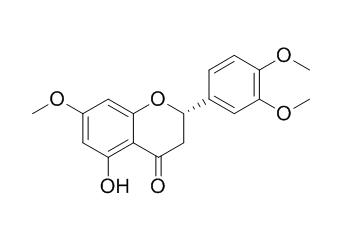7,3',4'-Tri-O-methyleriodictyol
7, 3',4'-Tri-O-methyleriodictyol has antimutagenic activity.
Inquire / Order:
manager@chemfaces.com
Technical Inquiries:
service@chemfaces.com
Tel:
+86-27-84237783
Fax:
+86-27-84254680
Address:
1 Building, No. 83, CheCheng Rd., Wuhan Economic and Technological Development Zone, Wuhan, Hubei 430056, PRC
Providing storage is as stated on the product vial and the vial is kept tightly sealed, the product can be stored for up to
24 months(2-8C).
Wherever possible, you should prepare and use solutions on the same day. However, if you need to make up stock solutions in advance, we recommend that you store the solution as aliquots in tightly sealed vials at -20C. Generally, these will be useable for up to two weeks. Before use, and prior to opening the vial we recommend that you allow your product to equilibrate to room temperature for at least 1 hour.
Need more advice on solubility, usage and handling? Please email to: service@chemfaces.com
The packaging of the product may have turned upside down during transportation, resulting in the natural compounds adhering to the neck or cap of the vial. take the vial out of its packaging and gently shake to let the compounds fall to the bottom of the vial. for liquid products, centrifuge at 200-500 RPM to gather the liquid at the bottom of the vial. try to avoid loss or contamination during handling.
Chulalongkorn University2024, ssrn.4716057.
Aquaculture2017, 481:94-102
Industrial Food Engineering2015, 19(4):408-413
Cell.2022, 185(23):4298-4316.e21.
J Hematol Oncol.2018, 11(1):112
Molecules.2023, 28(9):3685.
Adv Healthc Mater.2024, 13(13):e2303276.
Evid Based Complement Alternat Med.2021, 8707280.
Synthetic and Systems Biotechnology2023, j.synbio.
Trop J Nat Prod Res.2019, 3(1):6-9
Related and Featured Products
Eriodictyol 7,3'-dimethyl ether
Catalog No: CFN89533
CAS No: 54352-60-2
Price: Inquiry(manager@chemfaces.com)
Hesperetin
Catalog No: CFN98842
CAS No: 520-33-2
Price: $40/20mg
Hesperetin-7-methyl ether
Catalog No: CFN90876
CAS No: N/A
Price: $198/10mg
7,3',4'-Tri-O-methyleriodictyol
Catalog No: CFN89491
CAS No: 70987-96-1
Price: Inquiry(manager@chemfaces.com)
(2S)-5,7,3',4'-tetramethoxyflavanone
Catalog No: CFN95406
CAS No: 74628-43-6
Price: $318/10mg
5,6,7,3',4'-Pentamethoxyflavanone
Catalog No: CFN95394
CAS No: 104193-93-3
Price: $318/5mg
Isookanin
Catalog No: CFN90850
CAS No: 1036-49-3
Price: $298/20mg
Flavanomarein
Catalog No: CFN91006
CAS No: 577-38-8
Price: $358/5mg
Plathymenin
Catalog No: CFN96496
CAS No: 492-12-6
Price: Inquiry(manager@chemfaces.com)
Eriodictyol
Catalog No: CFN99719
CAS No: 552-58-9
Price: $128/20mg
J Agric Food Chem. 2000 Mar;48(3):642-7.
Antimutagenic activity of flavonoids from Pogostemon cablin.[Pubmed:
10725128]
METHODS AND RESULTS:
A methanol extract from Pogostemon cablin showed a suppressive effect on umu gene expression of SOS response in Salmonella typhimurium TA1535/pSK1002 against the mutagen 2-(2-furyl)-3-(5-nitro-2-furyl)acrylamide (furylfuramide).
The methanol extract was re-extracted with hexane, dichloromethane, butanol, and water. A dichloromethane fraction showed a suppressive effect. Suppressive compounds against furylfuramide in the dichloromethane fraction were isolated by SiO(2) column chromatography and identified as 7,4'-di-O-methyleriodictyol (1), 7,3',4'-Tri-O-methyleriodictyol (2), and 3,7,4'-tri-O-methylkaempferol (3). In addition, three flavonoids, ombuine (4), pachypodol (5), and kumatakenin (6), were isolated and identified from the dichrolomethane fraction. Compounds 1 and 3 suppressed >50% of the SOS-inducing activity at <0.6 micromol/mL, and the ID(50) values of both compounds were 0.25 micromol/mL. Compound 2 showed a weakly suppressive effect (17%) at a concentration of 0.6 micromol/mL, and compounds 4-6 did not. These compounds were also assayed with 3-amino-1,4-dimethyl-5H-pyrido[4,3-b]indole (Trp-P-1), which requires liver metabolizing enzymes. Compounds 3-6 suppressed >80% of the SOS-inducing activity of Trp-P-1 at <0.06 micromol/mL, and compounds 1 and 2 suppressed 87 and 63% at a concentration of 0.3 micromol/mL.
In addition, these compounds were assayed with activated Trp-P-1, and the suppressed effects of these compounds were further decreased when compared to Trp-P-1.
CONCLUSIONS:
The antimutagenic activities of these compounds against furylfuramide, Trp-P-1, and activated Trp-P-1 were assayed by the Ames test using S. typhimurium TA100.



